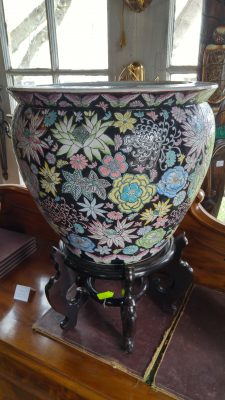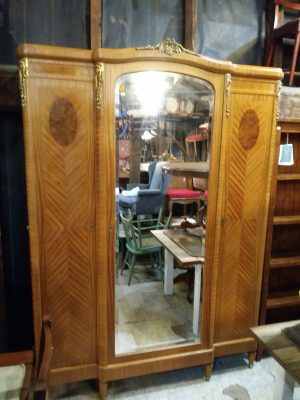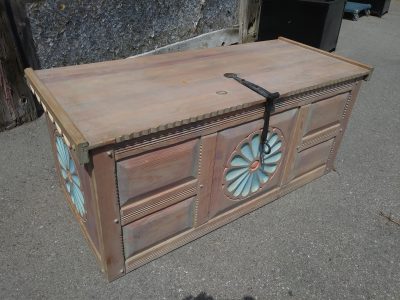Quarantine Series: The Cleveland Bank
If you scroll down this page and click on older entries, you will see previous posts from our Quarantine Series. We posted the first article in the series nearly a year ago on May 12th, 2020. And what a year it has been. This will be the 14th article we have posted in the series, and we’ve covered a lot of different topics, from the history of The Barn, to Film & television production, to antique pricing, and many more. We have told lots of different stories from The Barn’s past, but it occurred to us that we have told several different stories about how things have gone wrong over the years. So, I figured it was time to post an article about a big project that went right. Below is the story of perhaps the best deal in the history of The Barn.
From the early 1970’s through 1987 The Barn imported an enormous quantity of antiques from Cleveland and the surrounding area. Cleveland is a city with a long history and was an affluent city for many decades. However, during this period Cleveland had fallen on hard times. Back then it was known as a poor city and for several years had the highest crime rate of any city in America. However, because of its affluent past there was lots of great antiques in Cleveland that cloud be bought at low prices. We had a 40foot trailer that made so many trips between The Barn and Cleveland that we named it the Cleveland trailer.
The best business partners The Barn has ever had were an antique dealer couple operating in Cleveland Ohio named Jack and Seil Kilbane. They would buy antiques from the public and from other antique dealers throughout Ohio until they had accumulated enough to fill a 40foot trailer, then Frank[the owner of The Barn] would drive down, load up, and drive back.
One of the keys to this relationship was that the Kilbane’s had 30,000 square feet of storage for free. Cleveland was very rundown at this time and there was lots of abandoned buildings and empty warehouses. Companies from all over North America took to buying or renting warehouse space in Cleveland because it was a fraction of the cost of any other city. The only problem was getting robbed, which would happen frequently.
Seil Kilbane’s brother bought a warehouse that had three floors each of which was approximately 30,000 square feet. He planned to just hold on to the building until things had turned around and the area was ready for redevelopment. Believe it or not the top two floors were rented out to the CNE. They used to store all their stuffed animal prises and equipment there between exhibitions. Apparently, it was cheaper to truck everything to Cleveland and back every year than it was to rent storage in Toronto back then. The third floor of the warehouse was used by the Kilbane’s free of charge. So, they had lots of room for storage, which is very important if you are going to deal in antique furniture.
The warehouse was in a particularly rough neighbourhood, and Cleveland had a lot of rough neighbourhoods back then. And back then antiques were extremely valuable. However, the warehouse was never burglarized. How is that possible? The answer is that less than half a block away was a 24-hour restaurant that was owned by a group of cops. It was where all the cops eat during their sifts. Since there was always lots of cops around no one dared to try and rob the place.
You still had to get the trailer loaded and get on the highway before dark, just in case your truck broke down. It was not a place you wanted to be after dark. I remember being at the warehouse as a kid and I was too young to help load. I found a shot gun shell on the ground. I guess I was getting in the way, so to keep me busy Jack gave me the job of going around the warehouse and picking up all the ammunition I could find. By the end of the day, I had a box full. It was a rough neighbourhood.
Somewhere around 1980, we don’t remember the exact year, the Euclid National Bank of Cleveland decided it was time for a major renovation. The bank had two floors above ground with high vaulted ceilings, and three floors below ground with an enormous collection of safety deposit boxes. Things were so bad in Cleveland in those days that no one dared to keep their valuables at home, everyone it seemed had a safety deposit box.
The bank was decorated at a time when banks were designed to look impressive to attract customers. Nothing like today’s banks. This was a large bank packed with Kittinger desks, Baker desks, cabinets, and tables, approximately 140 RomWeber oak upholstered chairs, and five complete RomWeber boardroom sets. There were also large crystal chandeliers that were very high up, and no one seemed to know how to get them down. For those who don’t recognize those names, they are some of the best furniture makers in American history.
The bank management was taking offers on buying the furniture, chandeliers, and all the bank’s fixtures. But they had some very specific requirements. They wanted one company to take everything, and you had to take everything. You were not allowed to leave anything behind. This was part of the contract, and if everything wasn’t out by a certain date there was significant financial penalties in the contract. After all they were a bank, they knew how to write financial penalties into a contract.
The Euclid National Bank of Cleveland was of course located on Euclid Avenue. Yonge street in Toronto is a good comparison for Euclid Avenue. It was a busy two-lane street and you were not allowed to park on Euclid Avenue. Nothing was allowed to go out the front door either.
Because this was such a large and difficult project none of the local antique dealers wanted to bid on the deal. There was a lot of heavy furniture to move which no one wanted to do. Also, no one knew how to get everything out, or how to get the chandeliers down. And It was the equivalent of three 40foot trailers worth of stuff fully packed, most dealers didn’t have that much space. Plus, there was the contract.
Jack brought the deal to Frank and encouraged him to buy it. Jack had connections with just about everyone in Cleveland, including a local construction company. His plan was to get a scissor crane to take the chandeliers down. Also, to park the trailer on a side street. Take out a second story window and use a construction roller ramp from the second story window to the ground. From there the furniture would have to be walked around the corner to the trailer.
Because no one was willing to bid Jack suggested that Frank make a ridiculously low offer. He said they would have to take it because they had no other options. Frank offer $9500, and he thought they would never accept, they did.
Amazingly, everything worked out exactly according to plan. The biggest difficulty was getting everything from the three basement levels up the second story. There were elevators, but it was still a lot of work.
Most items went to the warehouse first, and eventually it took three trips of the Cleveland trailer to get everything back to The Barn. By the end there was no space left in The Barn and there were still 35 large oak office desks left over. Somehow it was decided the best thing to do was to cover them with a tarp and strap them to The Barn. So that’s what they did. The 140 Rom RomWeber chairs went in the basement at The Barn. This was before we built a staircase down to the basement. In those days it was a treacherous dirt sloop down to the basement that was difficult to navigate when it rained or snowed.
Frank remembers the first thing he sold was one of the five boardroom sets. He sold it to Kennedy Galleries for the same amount he paid the bank for everything. Even back then, that was an incredibly low price for such a set. Needless to say, the deal worked out very well.



